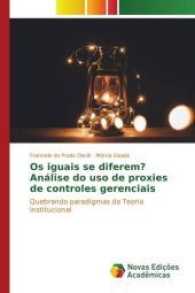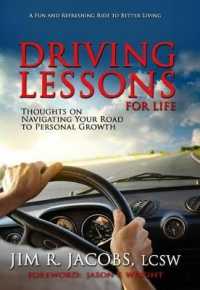- ホーム
- > 洋書
- > 英文書
- > Psychology
Full Description
According to the OECD (Organization for Economic Cooperation and Development), in the
21st century, we are living in a New Age of Biology, acknowledging the rapid development
of transformative findings in the life sciences. The Routledge Handbook of Neuroscience and
the Built Environment shows how these new findings impact architecture, planning, and
design, changing our understanding how people respond to their surroundings, and how
these environments can be optimized for human well-being.
A total of 31 chapters, presented in six sections, discuss human perception, the need
for connection, and how design impacts health and well-being, through topics such as
neuroaesthetics, color, memory and place, proportion, sound, neurophenomenology,
neurodiversity, biophilia, beauty, artificial intelligence, among many others. Expert
international contributors look to answer key questions as follows: What do architects and
designers need to know about neuroscience? How does architecture and design impact us
non-consciously? Why is acknowledging the human subliminal experience important? What
tools can designers use to "see" our subliminal behaviors?
This volume will be important reading for the design community, whether practicing,
educating, or studying, as well as policy makers and public health professionals.
Contents
Introductions: Susan Magsamen and Michael Mehaffy Part I: Embracing Human Evolution and Biology in Architecture 1. Architectural Aesthetics: Health & Wellbeing Vasiliki Meletaki and Anjan Chatterjee 2. Neuroaesthetics and Evolution Alexandros A. Lavdas 3. Agency and the Quality of Relationships as Environmental Variables A. Vernon Woodworth 4. Our "Animal Brain" Processes Vehicles as Animals: Architects and Policymakers Need to Acknowledge That Nir Buras and Anaami Pandit-Haji 5. Harmony in Design: Leveraging Human Biology for Aesthetic Wellbeing Natalie Ricci and Donald H. Ruggles Part II: Perception, Processing and Memory 6. Attention is Currency: Exploring how First Fixations in Architecture are as Important as in Advertising Ann Sussman and Abigail C. Sekely 7. A Guide to Fractal Fluency: Designing Biophilic Art and Architecture to Promote Occupants' Health and Performance Richard Taylor, Anastasija Lesjak and Martin Lesjak 8. A Map in the Brain for Space, Memory and Imagination Kate Jeffrey 9. Mind and Brain in Architecture: Reviewing the Impact of Angular Versus Curved Designs Nour Tawil and Simone Kühn 10. Unlocking the Hidden Power of Color in Design Roz Kavander and Linda Kafka 11. Weaving Memories into Place - Exploring the Relation between the Built Environment and Associative Memory Dylan Chau Huynh, Lars Brorson Fich & Zakaria Djebbara 12. Proportion - Creation of Harmony through Architecture using Sound as a Medium Pooja Mahathi Vajjha Part III: Human Social Behavior and Need for Connection with Others and Ourselves 13. Translating the Architecture of the Brain to the City Alexander Adams 14. Rhythm and Resonance in Architectural Experience Sarah Robinson 15. Shaping Behavior through Spaces: Science-Informed Architecture for Nurturing Cognitive Reserve Andréa de Paiva 16. Drawing from Within: Immersive Sketching as Neuroscientific Inquiry Cara Armstrong Part IV: Going Beyond Ourselves, Experiencing the Sacred 17. Seeing and Believing: How Physical and Temporal Context, Subject Matter, and Artistic Style Affect Viewers' Encounters with Sacred Art Robin Jensen 18. Neurophenomenology and Sacred Architecture Julio Bermudez and Yoshio Nakamura Part V: Neurodiversity, Stress, Trauma and Healing 19. Design for Wellbeing: Understanding the Impact of Architecture on Physiological Stress Cleo Valentine and Heather Mitcheltree 20. Neurodiversity in Architecture: How Neurodiverse Architects Shaped our World and How We are Shaping our World for Neurodiversity Evon Calabrese 21. Enhancing Well-being and Productivity through Biophilic Design:Integrating Nature into Built Environments Lori Crizel 22. The Role of Beauty in Promoting Wellbeing via the Built Environment Rhett Diessner Part VI: Building a Future for Human Health and Wellbeing 23. Rethinking Healthcare Design for Enhanced User Experience Vittoria Falchini and Rosi Pachilova 24. The Impact of Architecture on Wellbeing through Sound, Noise, and Silence Frven Lim 25. The Value of Pocket Parks in the 21st Century Gideon Spanjar, Frank Suurenbroek, Zahra Alinam, Justin B. Hollander, Regiena Stolp, Abigail C. Sekely, and Sába Schramkó 26. Advancing Evidence-Based Design (EBD) with Biosensor Integration: A Pathway to Data-Enriched Architectural Solutions Lori Crizel 27. Neuroscience and AI Determine Architectural Knowledge Nikos Salingaros 28. An Architectural Research Framework for Neuroscience of Human Experience Tulay Karakas and Dilek Yildiz Ozkan 29. Activating Salutogenesis: Environmental Enrichment, Embodiment, and Embreathment in Placemaking Tye Farrow 30. Translating Science: Promoting Cross-Disciplinary Application through Clear Communication Veronica Gianinni 31. In Search of Our Place in the World A. Vernon Woodworth








